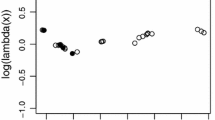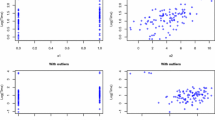Abstract
Accelerated failure time (AFT) model is a useful semi-parametric model under right censoring, which is an alternative to the commonly used proportional hazards model. Making statistical inference for the AFT model has attracted considerable attention. However, it is difficult to compute the estimators of regression parameters due to the lack of smoothness for rank-based estimating equations. Brown and Wang (Stat Med 26(4):828–836, 2007) used an induced smoothing approach, which smooths the estimating functions to obtain point and variance estimators. In this paper, a more computationally efficient method called jackknife empirical likelihood (JEL) is proposed to make inference for the accelerated failure time model without computing the limiting variance. Results from extensive simulation suggest that the JEL method outperforms the traditional normal approximation method in most cases. Subsequently, two real data sets are analyzed for illustration of the proposed method.
Similar content being viewed by others
References
Brown B, Wang Y-G (2005) Standard errors and covariance matrices for smoothed rank estimators. Biometrika 92(1):149–158
Brown B, Wang Y-G (2007) Induced smoothing for rank regression with censored survival times. Stat Med 26(4):828–836
Buckley J, James I (1979) Linear regression with censored data. Biometrika 66(3):429–436
Chen B, Pan G, Yang Q, Zhou W (2015) Large dimensional empirical likelihood. Stat Sin 25:1659–1677
Chiou S, Kang S, Yan J (2015) Rank-based estimating equations with general weight for accelerated failure time models: an induced smoothing approach. Stat Med 34(9):1495–1510
Chiou SH, Kang S, Yan J (2014a) Fast accelerated failure time modeling for case-cohort data. Stat Comput 24(4):559–568
Chiou SH, Kang S, Yan J et al (2014b) Fitting accelerated failure time models in routine survival analysis with R package aftgee. J Stat Softw 61(11):1–23
Cox DR (1972) Regression models and life-tables. J Roy Stat Soc Ser B (Methodol) 34(2):187–220
D’angio G J, Breslow N, Beckwith J B, Evans A, Baum E, Delorimier A, Fernbach D, Hrabovsky E, Jones B, Kelalis P et al (1989) Treatment of wilms’ tumor. results of the third national wilms’ tumor study. Cancer 64(2):349–360
Fygenson M, Ritov Y (1994) Monotone estimating equations for censored data. Ann Stat 22(2):732–746
Heller G (2007) Smoothed rank regression with censored data. J Am Stat Assoc 102(478):552–559
Jin Z, Lin D, Wei L, Ying Z (2003) Rank-based inference for the accelerated failure time model. Biometrika 90(2):341–353
Jing B-Y, Yuan J, Zhou W (2009) Jackknife empirical likelihood. J Am Stat Assoc 104(487):1224–1232
Johnson LM, Strawderman RL (2009) Induced smoothing for the semiparametric accelerated failure time model: asymptotics and extensions to clustered data. Biometrika 96(3):577–590
Kalbfleisch JD, Prentice RL (1980) The statistical analysis of failure time data. Wiley, New York
Li Z, Xu J, Zhou W (2016) On nonsmooth estimating functions via jackknife empirical likelihood. Scand J Stat 43(1):49–69
Lu W, Liang Y (2006) Empirical likelihood inference for linear transformation models. J Multivar Anal 97(7):1586–1599
McGilchrist C, Aisbett C (1991) Regression with frailty in survival analysis. Biometrics 47(2):461–466
Owen AB (1988) Empirical likelihood ratio confidence intervals for a single functional. Biometrika 75(2):237–249
Owen AB (1990) Empirical likelihood ratio confidence regions. Ann Stat 18(1):90–120
Owen AB (2001) Empirical likelihood. CRC Press, London
Prentice RL (1978) Linear rank tests with right censored data. Biometrika 65(1):167–179
Qin J, Lawless J (1994) Empirical likelihood and general estimating equations. Ann Stat 22:300–325
Thomas DR, Grunkemeier GL (1975) Confidence interval estimation of survival probabilities for censored data. J Am Stat Assoc 70(352):865–871
Tsiatis AA (1990) Estimating regression parameters using linear rank tests for censored data. Ann Stat 18(1):354–372
Wang Y-G, Fu L (2011) Rank regression for accelerated failure time model with clustered and censored data. Comput Stat Data Anal 55(7):2334–2343
Wei L-J, Ying Z, Lin D (1990) Linear regression analysis of censored survival data based on rank tests. Biometrika 77(4):845–851
Wilks SS (1938) The large-sample distribution of the likelihood ratio for testing composite hypotheses. Ann Math Stat 9(1):60–62
Yang H, Liu S, Zhao Y (2016) Jackknife empirical likelihood for linear transformation models with right censoring. Ann Inst Stat Math 68(5):1095–1109
Yang H, Zhao Y (2012) New empirical likelihood inference for linear transformation models. J Stat Plan Inference 142:1659–1668
Ying Z (1993) A large sample study of rank estimation for censored regression data. Ann Stat 21(1):76–99
Yu W, Sun Y, Zheng M (2011) Empirical likelihood method for linear transformation models. Ann Inst Stat Math 63(2):331–346
Zeng D, Lin D (2008) Efficient resampling methods for nonsmooth estimating functions. Biostatistics 9(2):355–363
Zhao Y, Meng X, Yang H (2015) Jackknife empirical likelihood inference for the mean absolute deviation. Comput Stat Data Anal 91:92–101
Zhao Y, Yang S (2012) Empirical likelihood confidence intervals for regression parameters of the survival rate. J Nonparametr Stat 24(1):59–70
Acknowledgements
We would like to thank the Editor-in-Chief and two reviewers for their excellent comments, which have helped to improve the manuscript significantly. Yichuan Zhao acknowledges the support from both NSF and NSA Grants.
Author information
Authors and Affiliations
Corresponding author
Appendix A: Proofs of Theorems
Appendix A: Proofs of Theorems
To derive the asymptotic properties of \(l(\beta _0)\) and \(l^*(\beta _{10})\), we assume some regularity conditions hold.
-
(C.1)
X is bounded, that is, \(P(\left\| X \right\| \le M) = 1\) for some \(0<M<\infty \).
-
(C.2)
The conditional distribution \({F_{{e_1}(\beta )\left| {{X_1}} \right. }}(t)\) of \({e_1}(\beta ) = {Y_1} - {\beta ^T}{X_1}\) given \(X_1\) is twice continuously differentiable in t for all X.
-
(C.3)
For any X, the conditional density function \({{F'}_{{e_1}(\beta )\left| {{X_1}} \right. }}(t) = {f_{{e_1}(\beta )\left| {{X_1}} \right. }}(t) > 0\) for t in a neighborhood of 0.
Firstly, we re-express the smoothed rank estimating function \({{ S}_n}(\beta )\) in (2.2) as a U-statistic with a symmetric kernel function.
because of \(r_{ij}^2 = {({X_i} - {X_j})^T}({X_i} - {X_j})/n\), one has that \({r_{ij}} = {r_{ji}}\),
where \(S_n^*(\beta )\) is a U-statistic of degree 2
with the kernel function
Similarly, we can also derive \({{\tilde{S}}_n}(\beta )\) in (2.1) as a U-statistic with a symmetric kernel function, that is,
with the kernel function
Fygenson and Ritov (1994) pointed out that when evaluated that \({W_n}(\beta _0 )\) is asymptotically normal and has expectation zero. Furthermore, by (A.7) in Appendix of Johnson and Strawderman (2009), we have the asymptotically equivalence of \({{ U}_n}(\beta _0 )\) to \({W_n}(\beta _0 )\), \(\sqrt{n} \left\| {{{ U}_n}(\beta _0 ) - {W_n}(\beta _0 )} \right\| \xrightarrow {p} 0\), that is,
Then, \(E{U_n}(\beta _0 ) = E{W_n}(\beta _0 ) + E\left[ {{o_p}({n^{ - 1/2}})} \right] \). Hence, we can have \(E{U_n}({\beta _0}) \rightarrow 0\) as \(n \rightarrow \infty \).
Before proving Theorem 2.1, we display similar notations like Li et al. (2016). Define
Under conditions (C.1)–(C.3), following Jing et al. (2009) and Li et al. (2016), we will prove Lemmas A.1 to A.5.
Lemma A.1
Under conditions (C.1)–(C.3), as \(n \rightarrow \infty \), one has
Proof
From Li et al. (2016), we can conclude that \(\sqrt{n} {{W}_n}(\beta _0 )\) tends to have a normal distribution with mean 0 and covariance \(\Sigma _{p \times p}^{(\beta _0 )}\). Then, as \(n \rightarrow \infty \), by (A.1), we can derive that
and
Thus, Lemma A.1 holds. \(\square \)
Lemma A.2
Under conditions (C.1)–(C.3), with probability tending to one as \(n \rightarrow \infty \), the zero vector is contained in the interior of the convex hull of \(\left\{ {{{{\hat{Q}}}_1}(\beta _0 ),\ldots ,{{\hat{Q}}_n}(\beta _0 )} \right\} \).
Proof
Combining the Hoeffding decomposition, the proof of Lemma A.2 in Owen (1990) and Li et al. (2016), we complete the proof of Lemma A.2. \(\square \)
Lemma A.3
Under conditions (C.1)–(C.3), one has \({G^*}(\beta _0 ) = \Sigma _{p \times p}^{({\beta _0})} + o(1)\), a.s.
Proof
Combining Lemma A.1 in Li et al. (2016) and strong law of large numbers for U-statistics, we get \({W_n}(\beta _0)=o(1) \ a.s\). For \(l=1,\ldots ,r\), let \(\sigma _{H,l}^2(\beta _0) = Var({H_l}({Z_1},{Z_2};{\beta _0}))\). Since \(E[H_l^2({Z_1},{Z_2};\beta _0 )] < \infty \), \(\sigma _{H,l}^2(\beta _0)< \infty \). As a result,
From Lemma A.3 in Li et al. (2016), we have that
Also, since
it leads to
Furthermore,
Note that the first term \(\sum \nolimits _{i = 1}^n {{{\hat{Q}}_i}(\beta _0 )} {\hat{Q}}_i^T(\beta _0 )/n\) in Eq. (A.5) can be proved as \(\Sigma _{p \times p}^{({\beta _0})} + o(1)\;a.s.\)
Also, based on the strong law of large number for U-statistics, one has \({U_n}(\beta _0 ) = o(1)\) a.s. Therefore, \(G^* (\beta _0)= \Sigma _{p \times p}^{({\beta _0})} + o(1)\;a.s\). \(\square \)
Lemma A.4
Let \({A_n} = {\max _{1 \le i \ne j \le n}}\left\| {K({Z_1},{Z_2};\beta _0 )} \right\| \). Under the condition (C.1), we have \({A_n} = o({n^{1/2}})\) a.s.
Proof
By Borel–Cantelli lemma and Li et al. (2016), \({A_n} = o({n^{1/2}})\) a.s. \(\square \)
Lemma A.5
Let \({B_n} = {\max _{1 \le i \le n}}\left\| {{{{\hat{Q}}}_i}(\beta _0 )} \right\| \). Under conditions (C.1)–(C.3), \({B_n} = o({n^{1/2}})\) and \({n^{ - 1}}{\sum \nolimits _{i = 1}^n {\left\| {{{{\hat{Q}}}_i}(\beta _0 )} \right\| } ^3} = o({n^{1/2}})\).
Proof
We can check that
Then, for any \(1 \le i \le n\),
Combining (A.6) and the result of Lemma A.4, that is, \({A_n} = o({n^{1/2}})\) a.s., we prove Lemma A.5. \(\square \)
Proof of Theorem 2.1
We let \(\lambda =\rho \theta \), where \(\rho \ge 0\) and \(\left\| \theta \right\| = 1\). Let \(e_j\) be the unit vector on the jth coordinate direction. According to (2.5), we obtain that like Owen (2001) and Lu and Liang (2006),
We also have \({G^*}(\beta _0 ) = \Sigma _{p \times p}^{({\beta _0})} + o(1)\) a.s. from Lemma A.3. Thus, one has
Denote \({\eta _i} = {\lambda ^T}{{{\hat{Q}}}_i}({\beta _0})\). From Lemma A.5 and (A.7), we can obtain
where \(\left\| \gamma \right\| = {o_p}({n^{ - 1/2}})\). By Taylor expansion, we obtain that
In (A.8), the first term is \(nU_n^T(\beta _0 ){(G^*(\beta _0))^{ - 1}}{U_n}(\beta _0 )\mathop \rightarrow \limits ^d \chi _p^2\). Moreover, the second term is \(n{\gamma ^T}{G^*}(\beta _0)\gamma = n{o_p}({n^{ - 1/2}}){O_p}(1){o_p}({n^{ - 1/2}}) = {o_p}(1)\). Therefore, \( - 2\log R({\beta _0})\mathop \rightarrow \limits ^d \chi _p^2\). \(\square \)
Proof of Theorem 2.2
We follow the similar arguments in Yu et al. (2011) and Yang and Zhao (2012). Corresponding to \(\beta _0=(\beta _{10}^T, \beta _{20}^T)^T\), we denote \(Z=(Z_{1}^T, Z_{2}^T)^T\). Recall that \(\sqrt{n} (\hat{\beta }- {\beta _0})\) was asymptotically normally distributed with mean zero and variance-covariance matrix \(D_n{({\beta _0})^{ - 1}}B_n({\beta _0}){(D_n{({\beta _0})^{ - 1}})^T}\).
Define
Since \(D_n(\beta _0)\) is positive definite, \({\bar{D}}(\beta _0)\) is of rank \(p-q\). Denote
Similar to Qin and Lawless (1994), we can show that
and
where \(\lambda _2\) is the corresponding Lagrange multiplier. Recall that
Hence, by Taylor’s expansion, one has that
where
\(\Psi \) is a symmetric matrix with trace q. By Lemma A.1,
Then, we have that
The proof of Theorem 2.2 is completed. \(\square \)
Rights and permissions
About this article
Cite this article
Yu, X., Zhao, Y. Jackknife empirical likelihood inference for the accelerated failure time model. TEST 28, 269–288 (2019). https://doi.org/10.1007/s11749-018-0601-7
Received:
Accepted:
Published:
Issue Date:
DOI: https://doi.org/10.1007/s11749-018-0601-7




